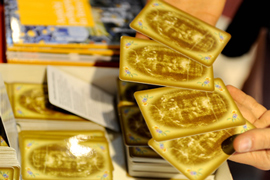Pilgrims flock to see Turin shroud
“Christ’s burial cloth”, shown only five times in last 100 years, to draw two million visitors.

“This is a man who has been barbarically slain and reduced to a pitiful condition.”
Medieval ‘hoax’
Sceptics argue the shroud is a medieval hoax, possibly made to attract the profitable pilgrimage business.
Carbon-dating tests by laboratories in Oxford, Zurich and Tucson, Arizona, USA, in 1988 caused a sensation by dating it from between 1260 and 1390 – implying it was a fake and could not be Christ’s burial cloth.
But scientists have been at a loss to explain how the image was left on the cloth.
Most agree it could not have been painted or printed and some have said the 1988 tests may have been faulty and results corrupted by bacteria encrusted over the centuries.
Passionate reminder
Last year an Italian scientist reproduced the full-sized shroud using materials and techniques he said were available in the Middle Ages – a feat that in his view proved definitively that the linen is a fake.
But believers have little doubt over the authenticity of the cloth.
“There’s something indefinable in finding Jesus Christ in front of you,” one visitor said.
 |
| Sceptics argue the shroud is a medieval hoax made only to attract business [AFP] |
After surfacing in the Middle East and France, the shroud was brought by Italy’s former royal family, the Savoys, to their seat in Turin in 1578.
In 1983 ex-King Umberto II bequeathed it to the late Pope John Paul, the predecessor of Pope Benedict XVI.
The shroud narrowly escaped destruction in 1997 when a fire ravaged the Guarini Chapel of the Turin cathedral where it is normally kept rolled up in an ornate silver box.
The cloth was saved by a fireman who risked his life. The Catholic Church does not claim the shroud is authentic nor that it is a matter of faith, but says it should be a powerful reminder of Christ’s passion.
The shroud was shown only four times in the 20th century. The last time it was put on public display was for the Catholic jubilee year in 2000.
Two million visitors are expected to go and see it before the display ends on May 23.
Benedict, who is by tradition the owner of the cloth, is due to visit the shroud on May 2.